System Analysis and Design Report: Sydney Medical Centre Case Study
VerifiedAdded on 2021/01/02
|16
|2796
|439
Report
AI Summary
This report provides a comprehensive analysis of the Sydney Medical Centre (SMC) system, focusing on the development of a new IT software to improve efficiency. It details different types of system requirements, including functional (registration, report generation, database, and design constraints) and non-functional (reliability, accuracy, confidentiality, and performance) aspects. The report also explores various fact-finding methods, such as interviews, questionnaires, record reviews, and observations, used to gather information from employees. Furthermore, it identifies two system development tools, Public APIs and Wercker, and two development methodologies, Agile and Rapid Application Development, suitable for the project. The analysis includes use case and context diagrams, an Entity Relationship Diagram (ERD), and a 0-level Data Flow Diagram (DFD) to visually represent the system's architecture and processes. The goal is to create a new system that allows medical staff to check records, schedule appointments, and update medical information, leading to improved efficiency and cost savings for EMC.
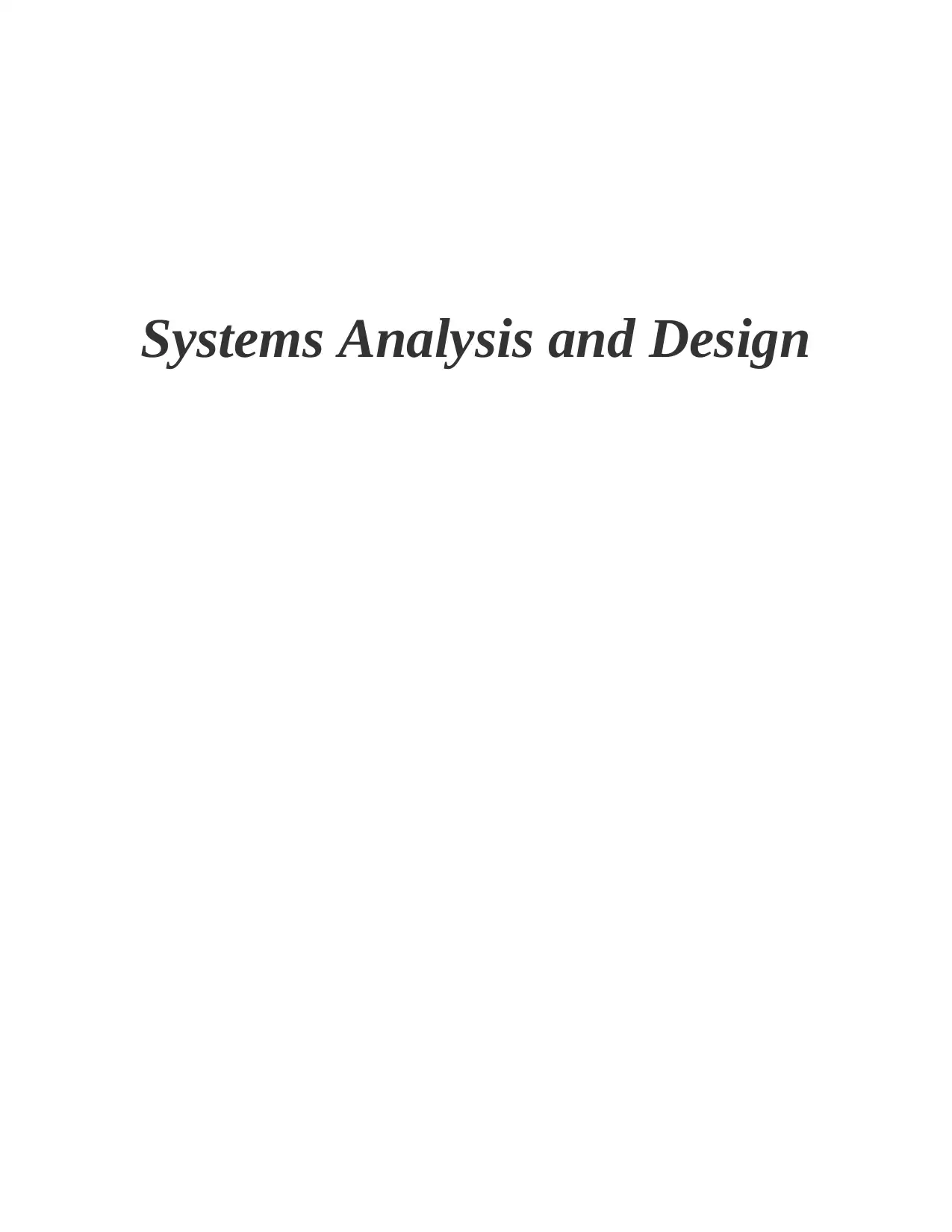
Systems Analysis and Design
Paraphrase This Document
Need a fresh take? Get an instant paraphrase of this document with our AI Paraphraser
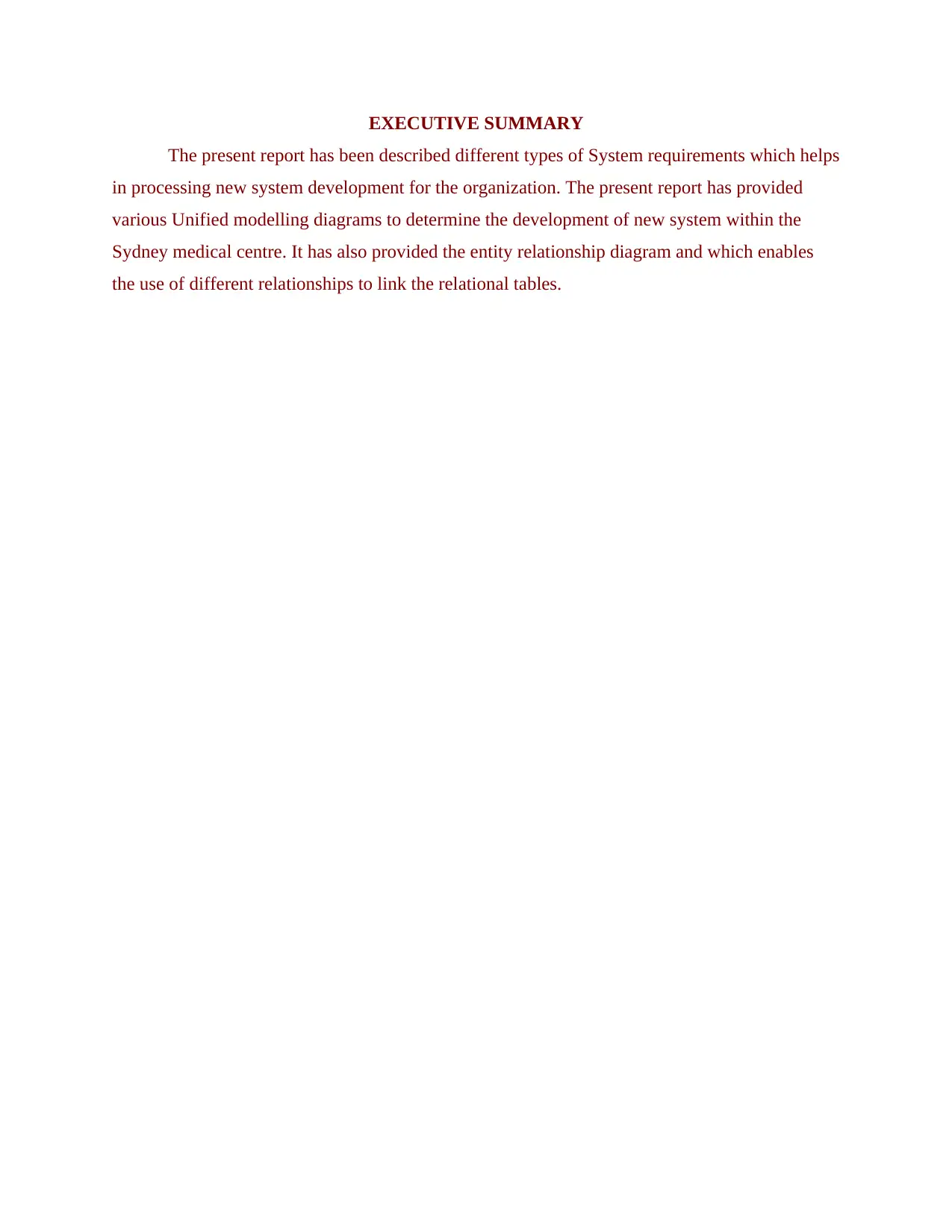
EXECUTIVE SUMMARY
The present report has been described different types of System requirements which helps
in processing new system development for the organization. The present report has provided
various Unified modelling diagrams to determine the development of new system within the
Sydney medical centre. It has also provided the entity relationship diagram and which enables
the use of different relationships to link the relational tables.
The present report has been described different types of System requirements which helps
in processing new system development for the organization. The present report has provided
various Unified modelling diagrams to determine the development of new system within the
Sydney medical centre. It has also provided the entity relationship diagram and which enables
the use of different relationships to link the relational tables.
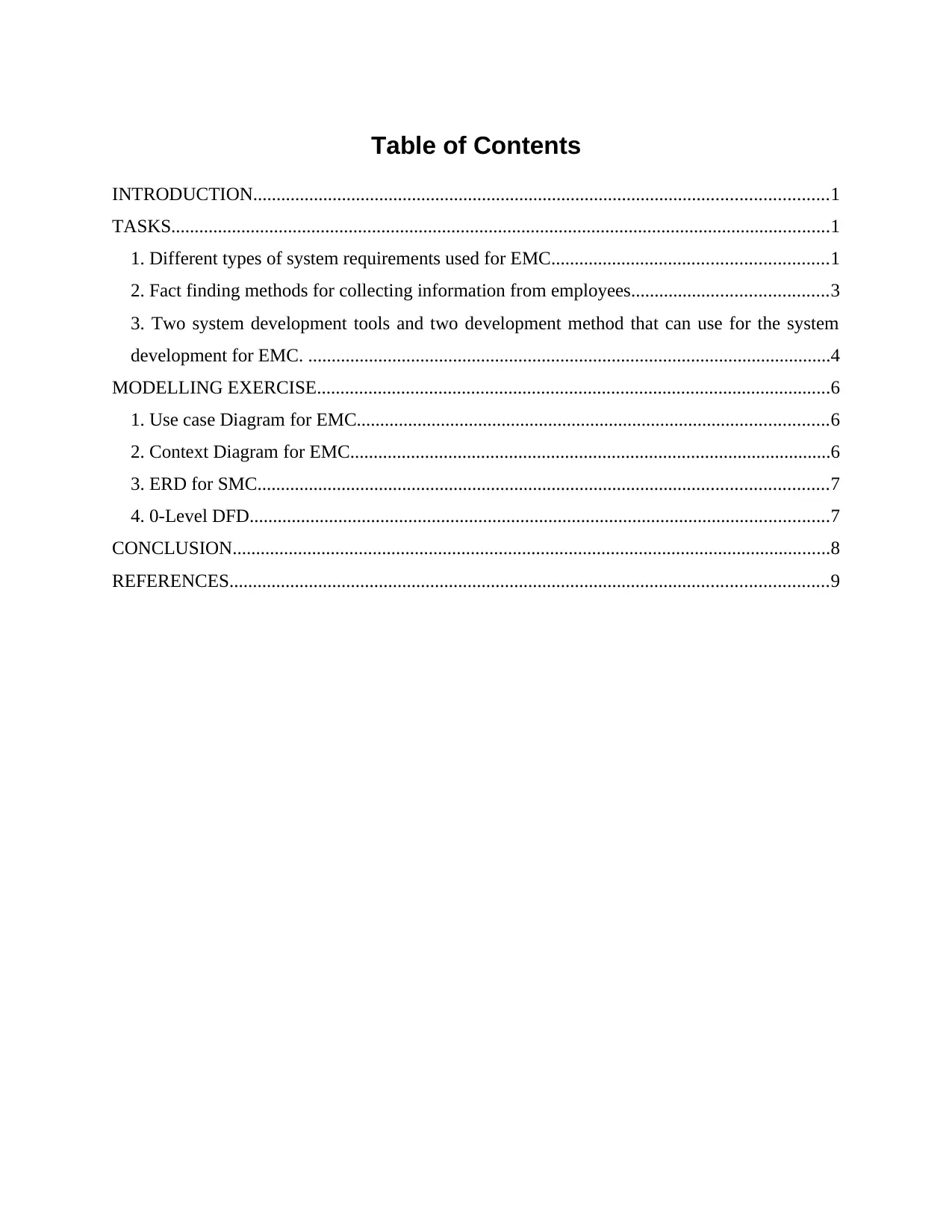
Table of Contents
INTRODUCTION...........................................................................................................................1
TASKS.............................................................................................................................................1
1. Different types of system requirements used for EMC...........................................................1
2. Fact finding methods for collecting information from employees..........................................3
3. Two system development tools and two development method that can use for the system
development for EMC. ................................................................................................................4
MODELLING EXERCISE..............................................................................................................6
1. Use case Diagram for EMC.....................................................................................................6
2. Context Diagram for EMC.......................................................................................................6
3. ERD for SMC..........................................................................................................................7
4. 0-Level DFD............................................................................................................................7
CONCLUSION................................................................................................................................8
REFERENCES................................................................................................................................9
INTRODUCTION...........................................................................................................................1
TASKS.............................................................................................................................................1
1. Different types of system requirements used for EMC...........................................................1
2. Fact finding methods for collecting information from employees..........................................3
3. Two system development tools and two development method that can use for the system
development for EMC. ................................................................................................................4
MODELLING EXERCISE..............................................................................................................6
1. Use case Diagram for EMC.....................................................................................................6
2. Context Diagram for EMC.......................................................................................................6
3. ERD for SMC..........................................................................................................................7
4. 0-Level DFD............................................................................................................................7
CONCLUSION................................................................................................................................8
REFERENCES................................................................................................................................9
⊘ This is a preview!⊘
Do you want full access?
Subscribe today to unlock all pages.

Trusted by 1+ million students worldwide
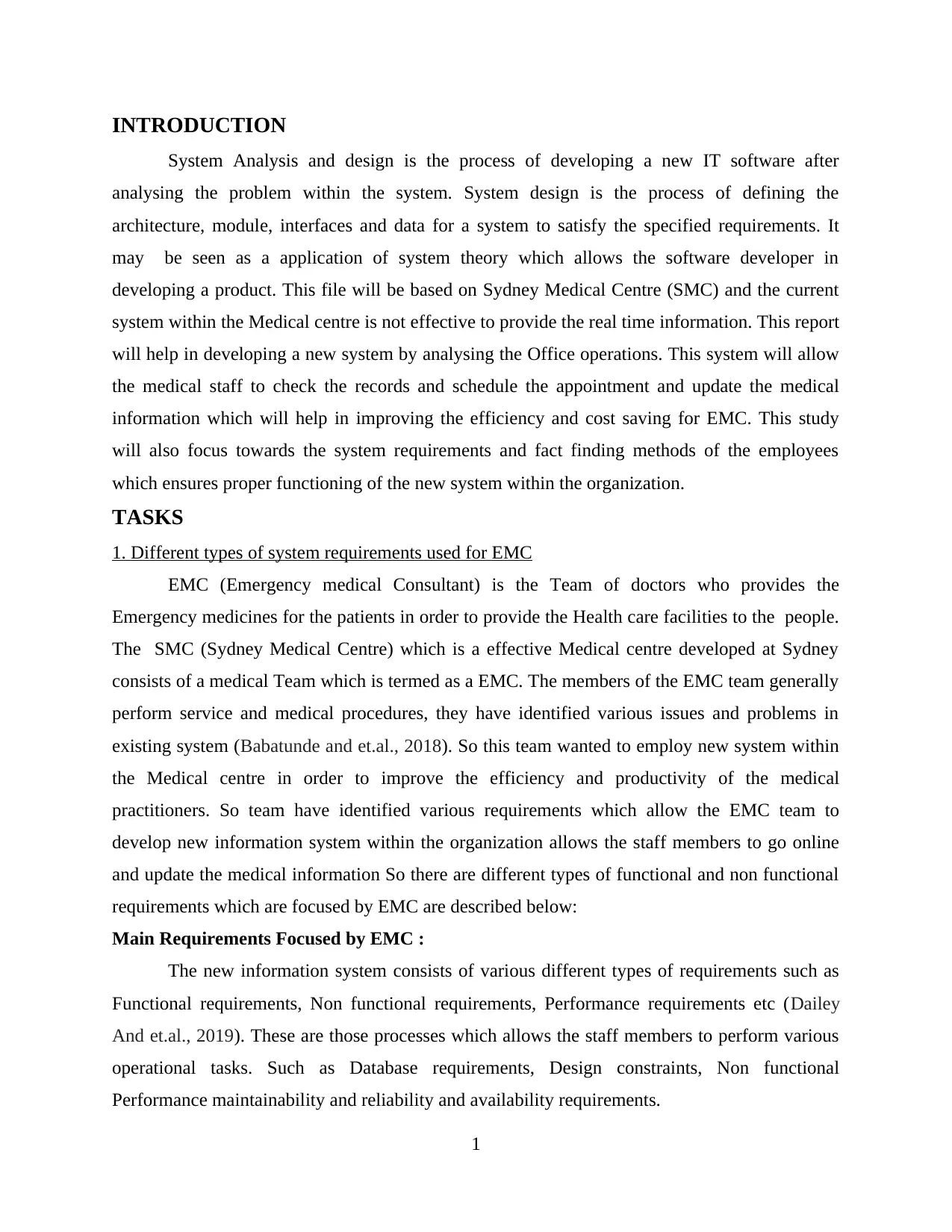
INTRODUCTION
System Analysis and design is the process of developing a new IT software after
analysing the problem within the system. System design is the process of defining the
architecture, module, interfaces and data for a system to satisfy the specified requirements. It
may be seen as a application of system theory which allows the software developer in
developing a product. This file will be based on Sydney Medical Centre (SMC) and the current
system within the Medical centre is not effective to provide the real time information. This report
will help in developing a new system by analysing the Office operations. This system will allow
the medical staff to check the records and schedule the appointment and update the medical
information which will help in improving the efficiency and cost saving for EMC. This study
will also focus towards the system requirements and fact finding methods of the employees
which ensures proper functioning of the new system within the organization.
TASKS
1. Different types of system requirements used for EMC
EMC (Emergency medical Consultant) is the Team of doctors who provides the
Emergency medicines for the patients in order to provide the Health care facilities to the people.
The SMC (Sydney Medical Centre) which is a effective Medical centre developed at Sydney
consists of a medical Team which is termed as a EMC. The members of the EMC team generally
perform service and medical procedures, they have identified various issues and problems in
existing system (Babatunde and et.al., 2018). So this team wanted to employ new system within
the Medical centre in order to improve the efficiency and productivity of the medical
practitioners. So team have identified various requirements which allow the EMC team to
develop new information system within the organization allows the staff members to go online
and update the medical information So there are different types of functional and non functional
requirements which are focused by EMC are described below:
Main Requirements Focused by EMC :
The new information system consists of various different types of requirements such as
Functional requirements, Non functional requirements, Performance requirements etc (Dailey
And et.al., 2019). These are those processes which allows the staff members to perform various
operational tasks. Such as Database requirements, Design constraints, Non functional
Performance maintainability and reliability and availability requirements.
1
System Analysis and design is the process of developing a new IT software after
analysing the problem within the system. System design is the process of defining the
architecture, module, interfaces and data for a system to satisfy the specified requirements. It
may be seen as a application of system theory which allows the software developer in
developing a product. This file will be based on Sydney Medical Centre (SMC) and the current
system within the Medical centre is not effective to provide the real time information. This report
will help in developing a new system by analysing the Office operations. This system will allow
the medical staff to check the records and schedule the appointment and update the medical
information which will help in improving the efficiency and cost saving for EMC. This study
will also focus towards the system requirements and fact finding methods of the employees
which ensures proper functioning of the new system within the organization.
TASKS
1. Different types of system requirements used for EMC
EMC (Emergency medical Consultant) is the Team of doctors who provides the
Emergency medicines for the patients in order to provide the Health care facilities to the people.
The SMC (Sydney Medical Centre) which is a effective Medical centre developed at Sydney
consists of a medical Team which is termed as a EMC. The members of the EMC team generally
perform service and medical procedures, they have identified various issues and problems in
existing system (Babatunde and et.al., 2018). So this team wanted to employ new system within
the Medical centre in order to improve the efficiency and productivity of the medical
practitioners. So team have identified various requirements which allow the EMC team to
develop new information system within the organization allows the staff members to go online
and update the medical information So there are different types of functional and non functional
requirements which are focused by EMC are described below:
Main Requirements Focused by EMC :
The new information system consists of various different types of requirements such as
Functional requirements, Non functional requirements, Performance requirements etc (Dailey
And et.al., 2019). These are those processes which allows the staff members to perform various
operational tasks. Such as Database requirements, Design constraints, Non functional
Performance maintainability and reliability and availability requirements.
1
Paraphrase This Document
Need a fresh take? Get an instant paraphrase of this document with our AI Paraphraser
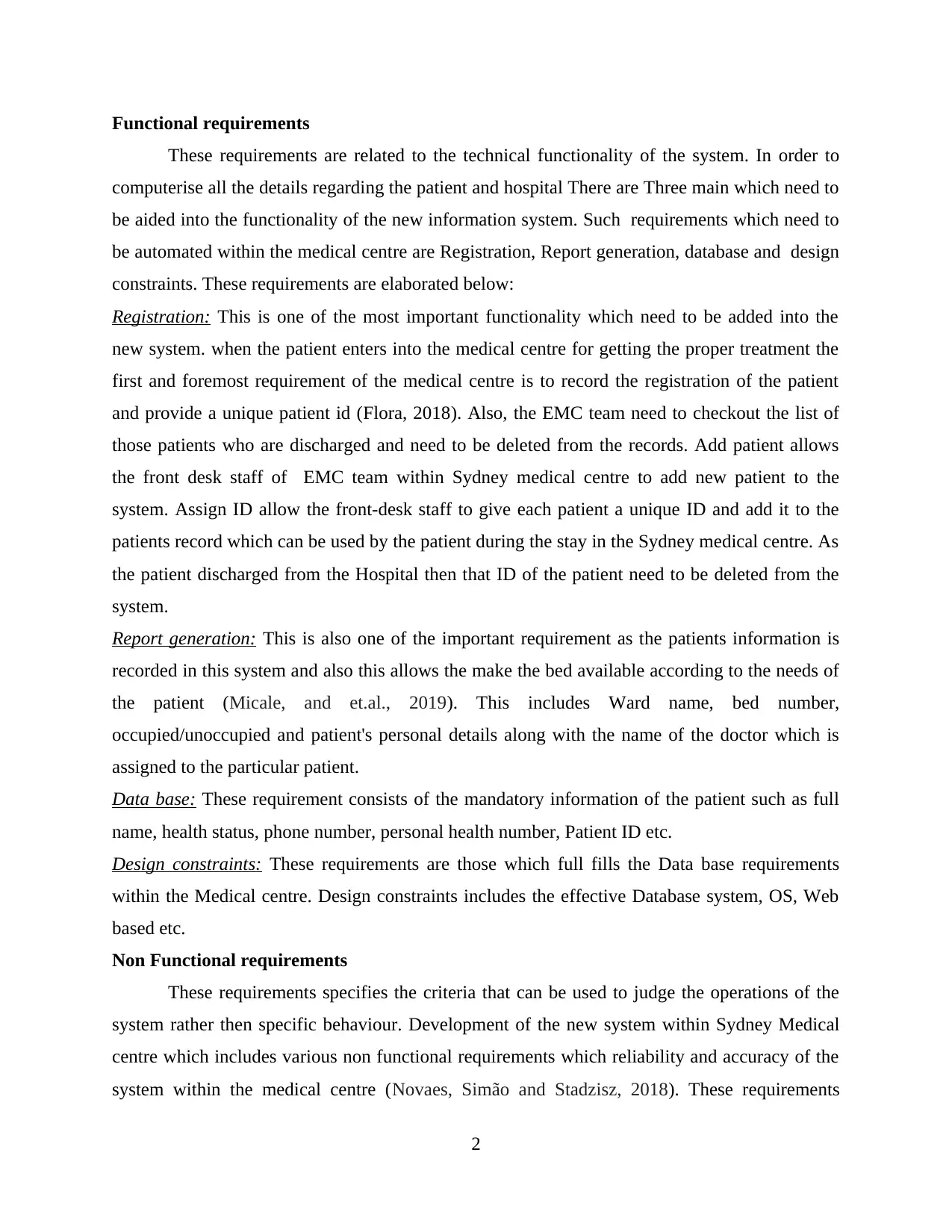
Functional requirements
These requirements are related to the technical functionality of the system. In order to
computerise all the details regarding the patient and hospital There are Three main which need to
be aided into the functionality of the new information system. Such requirements which need to
be automated within the medical centre are Registration, Report generation, database and design
constraints. These requirements are elaborated below:
Registration: This is one of the most important functionality which need to be added into the
new system. when the patient enters into the medical centre for getting the proper treatment the
first and foremost requirement of the medical centre is to record the registration of the patient
and provide a unique patient id (Flora, 2018). Also, the EMC team need to checkout the list of
those patients who are discharged and need to be deleted from the records. Add patient allows
the front desk staff of EMC team within Sydney medical centre to add new patient to the
system. Assign ID allow the front-desk staff to give each patient a unique ID and add it to the
patients record which can be used by the patient during the stay in the Sydney medical centre. As
the patient discharged from the Hospital then that ID of the patient need to be deleted from the
system.
Report generation: This is also one of the important requirement as the patients information is
recorded in this system and also this allows the make the bed available according to the needs of
the patient (Micale, and et.al., 2019). This includes Ward name, bed number,
occupied/unoccupied and patient's personal details along with the name of the doctor which is
assigned to the particular patient.
Data base: These requirement consists of the mandatory information of the patient such as full
name, health status, phone number, personal health number, Patient ID etc.
Design constraints: These requirements are those which full fills the Data base requirements
within the Medical centre. Design constraints includes the effective Database system, OS, Web
based etc.
Non Functional requirements
These requirements specifies the criteria that can be used to judge the operations of the
system rather then specific behaviour. Development of the new system within Sydney Medical
centre which includes various non functional requirements which reliability and accuracy of the
system within the medical centre (Novaes, Simão and Stadzisz, 2018). These requirements
2
These requirements are related to the technical functionality of the system. In order to
computerise all the details regarding the patient and hospital There are Three main which need to
be aided into the functionality of the new information system. Such requirements which need to
be automated within the medical centre are Registration, Report generation, database and design
constraints. These requirements are elaborated below:
Registration: This is one of the most important functionality which need to be added into the
new system. when the patient enters into the medical centre for getting the proper treatment the
first and foremost requirement of the medical centre is to record the registration of the patient
and provide a unique patient id (Flora, 2018). Also, the EMC team need to checkout the list of
those patients who are discharged and need to be deleted from the records. Add patient allows
the front desk staff of EMC team within Sydney medical centre to add new patient to the
system. Assign ID allow the front-desk staff to give each patient a unique ID and add it to the
patients record which can be used by the patient during the stay in the Sydney medical centre. As
the patient discharged from the Hospital then that ID of the patient need to be deleted from the
system.
Report generation: This is also one of the important requirement as the patients information is
recorded in this system and also this allows the make the bed available according to the needs of
the patient (Micale, and et.al., 2019). This includes Ward name, bed number,
occupied/unoccupied and patient's personal details along with the name of the doctor which is
assigned to the particular patient.
Data base: These requirement consists of the mandatory information of the patient such as full
name, health status, phone number, personal health number, Patient ID etc.
Design constraints: These requirements are those which full fills the Data base requirements
within the Medical centre. Design constraints includes the effective Database system, OS, Web
based etc.
Non Functional requirements
These requirements specifies the criteria that can be used to judge the operations of the
system rather then specific behaviour. Development of the new system within Sydney Medical
centre which includes various non functional requirements which reliability and accuracy of the
system within the medical centre (Novaes, Simão and Stadzisz, 2018). These requirements
2
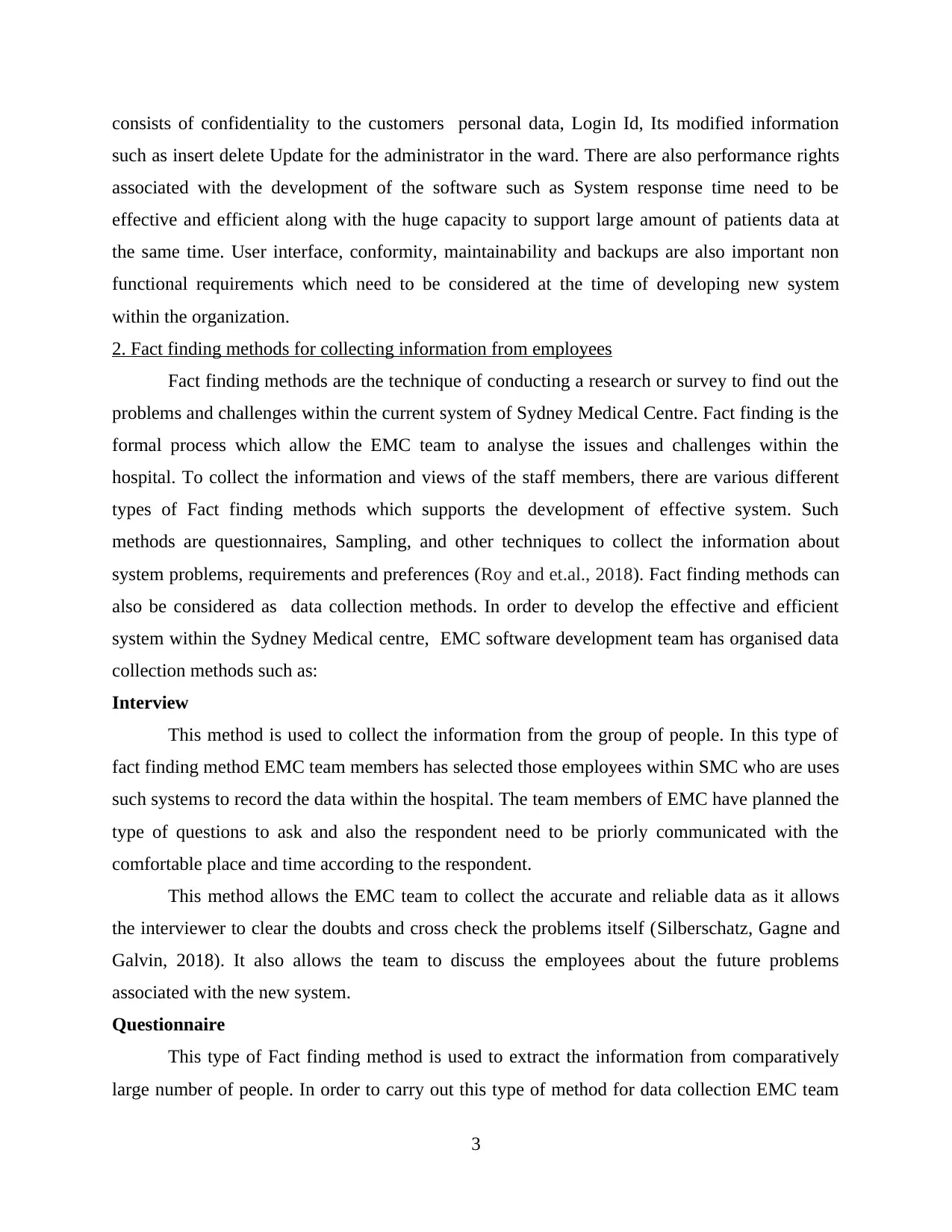
consists of confidentiality to the customers personal data, Login Id, Its modified information
such as insert delete Update for the administrator in the ward. There are also performance rights
associated with the development of the software such as System response time need to be
effective and efficient along with the huge capacity to support large amount of patients data at
the same time. User interface, conformity, maintainability and backups are also important non
functional requirements which need to be considered at the time of developing new system
within the organization.
2. Fact finding methods for collecting information from employees
Fact finding methods are the technique of conducting a research or survey to find out the
problems and challenges within the current system of Sydney Medical Centre. Fact finding is the
formal process which allow the EMC team to analyse the issues and challenges within the
hospital. To collect the information and views of the staff members, there are various different
types of Fact finding methods which supports the development of effective system. Such
methods are questionnaires, Sampling, and other techniques to collect the information about
system problems, requirements and preferences (Roy and et.al., 2018). Fact finding methods can
also be considered as data collection methods. In order to develop the effective and efficient
system within the Sydney Medical centre, EMC software development team has organised data
collection methods such as:
Interview
This method is used to collect the information from the group of people. In this type of
fact finding method EMC team members has selected those employees within SMC who are uses
such systems to record the data within the hospital. The team members of EMC have planned the
type of questions to ask and also the respondent need to be priorly communicated with the
comfortable place and time according to the respondent.
This method allows the EMC team to collect the accurate and reliable data as it allows
the interviewer to clear the doubts and cross check the problems itself (Silberschatz, Gagne and
Galvin, 2018). It also allows the team to discuss the employees about the future problems
associated with the new system.
Questionnaire
This type of Fact finding method is used to extract the information from comparatively
large number of people. In order to carry out this type of method for data collection EMC team
3
such as insert delete Update for the administrator in the ward. There are also performance rights
associated with the development of the software such as System response time need to be
effective and efficient along with the huge capacity to support large amount of patients data at
the same time. User interface, conformity, maintainability and backups are also important non
functional requirements which need to be considered at the time of developing new system
within the organization.
2. Fact finding methods for collecting information from employees
Fact finding methods are the technique of conducting a research or survey to find out the
problems and challenges within the current system of Sydney Medical Centre. Fact finding is the
formal process which allow the EMC team to analyse the issues and challenges within the
hospital. To collect the information and views of the staff members, there are various different
types of Fact finding methods which supports the development of effective system. Such
methods are questionnaires, Sampling, and other techniques to collect the information about
system problems, requirements and preferences (Roy and et.al., 2018). Fact finding methods can
also be considered as data collection methods. In order to develop the effective and efficient
system within the Sydney Medical centre, EMC software development team has organised data
collection methods such as:
Interview
This method is used to collect the information from the group of people. In this type of
fact finding method EMC team members has selected those employees within SMC who are uses
such systems to record the data within the hospital. The team members of EMC have planned the
type of questions to ask and also the respondent need to be priorly communicated with the
comfortable place and time according to the respondent.
This method allows the EMC team to collect the accurate and reliable data as it allows
the interviewer to clear the doubts and cross check the problems itself (Silberschatz, Gagne and
Galvin, 2018). It also allows the team to discuss the employees about the future problems
associated with the new system.
Questionnaire
This type of Fact finding method is used to extract the information from comparatively
large number of people. In order to carry out this type of method for data collection EMC team
3
⊘ This is a preview!⊘
Do you want full access?
Subscribe today to unlock all pages.

Trusted by 1+ million students worldwide
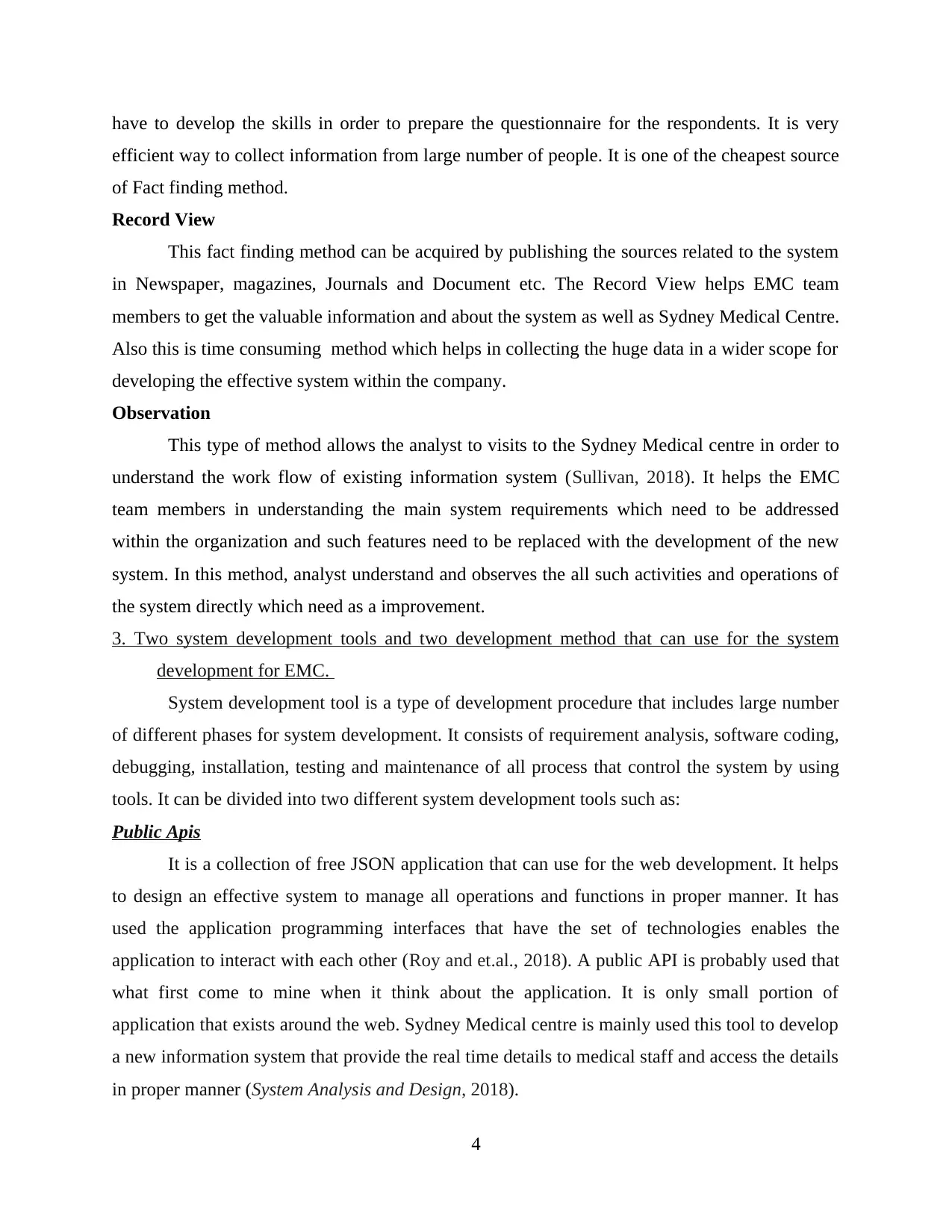
have to develop the skills in order to prepare the questionnaire for the respondents. It is very
efficient way to collect information from large number of people. It is one of the cheapest source
of Fact finding method.
Record View
This fact finding method can be acquired by publishing the sources related to the system
in Newspaper, magazines, Journals and Document etc. The Record View helps EMC team
members to get the valuable information and about the system as well as Sydney Medical Centre.
Also this is time consuming method which helps in collecting the huge data in a wider scope for
developing the effective system within the company.
Observation
This type of method allows the analyst to visits to the Sydney Medical centre in order to
understand the work flow of existing information system (Sullivan, 2018). It helps the EMC
team members in understanding the main system requirements which need to be addressed
within the organization and such features need to be replaced with the development of the new
system. In this method, analyst understand and observes the all such activities and operations of
the system directly which need as a improvement.
3. Two system development tools and two development method that can use for the system
development for EMC.
System development tool is a type of development procedure that includes large number
of different phases for system development. It consists of requirement analysis, software coding,
debugging, installation, testing and maintenance of all process that control the system by using
tools. It can be divided into two different system development tools such as:
Public Apis
It is a collection of free JSON application that can use for the web development. It helps
to design an effective system to manage all operations and functions in proper manner. It has
used the application programming interfaces that have the set of technologies enables the
application to interact with each other (Roy and et.al., 2018). A public API is probably used that
what first come to mine when it think about the application. It is only small portion of
application that exists around the web. Sydney Medical centre is mainly used this tool to develop
a new information system that provide the real time details to medical staff and access the details
in proper manner (System Analysis and Design, 2018).
4
efficient way to collect information from large number of people. It is one of the cheapest source
of Fact finding method.
Record View
This fact finding method can be acquired by publishing the sources related to the system
in Newspaper, magazines, Journals and Document etc. The Record View helps EMC team
members to get the valuable information and about the system as well as Sydney Medical Centre.
Also this is time consuming method which helps in collecting the huge data in a wider scope for
developing the effective system within the company.
Observation
This type of method allows the analyst to visits to the Sydney Medical centre in order to
understand the work flow of existing information system (Sullivan, 2018). It helps the EMC
team members in understanding the main system requirements which need to be addressed
within the organization and such features need to be replaced with the development of the new
system. In this method, analyst understand and observes the all such activities and operations of
the system directly which need as a improvement.
3. Two system development tools and two development method that can use for the system
development for EMC.
System development tool is a type of development procedure that includes large number
of different phases for system development. It consists of requirement analysis, software coding,
debugging, installation, testing and maintenance of all process that control the system by using
tools. It can be divided into two different system development tools such as:
Public Apis
It is a collection of free JSON application that can use for the web development. It helps
to design an effective system to manage all operations and functions in proper manner. It has
used the application programming interfaces that have the set of technologies enables the
application to interact with each other (Roy and et.al., 2018). A public API is probably used that
what first come to mine when it think about the application. It is only small portion of
application that exists around the web. Sydney Medical centre is mainly used this tool to develop
a new information system that provide the real time details to medical staff and access the details
in proper manner (System Analysis and Design, 2018).
4
Paraphrase This Document
Need a fresh take? Get an instant paraphrase of this document with our AI Paraphraser
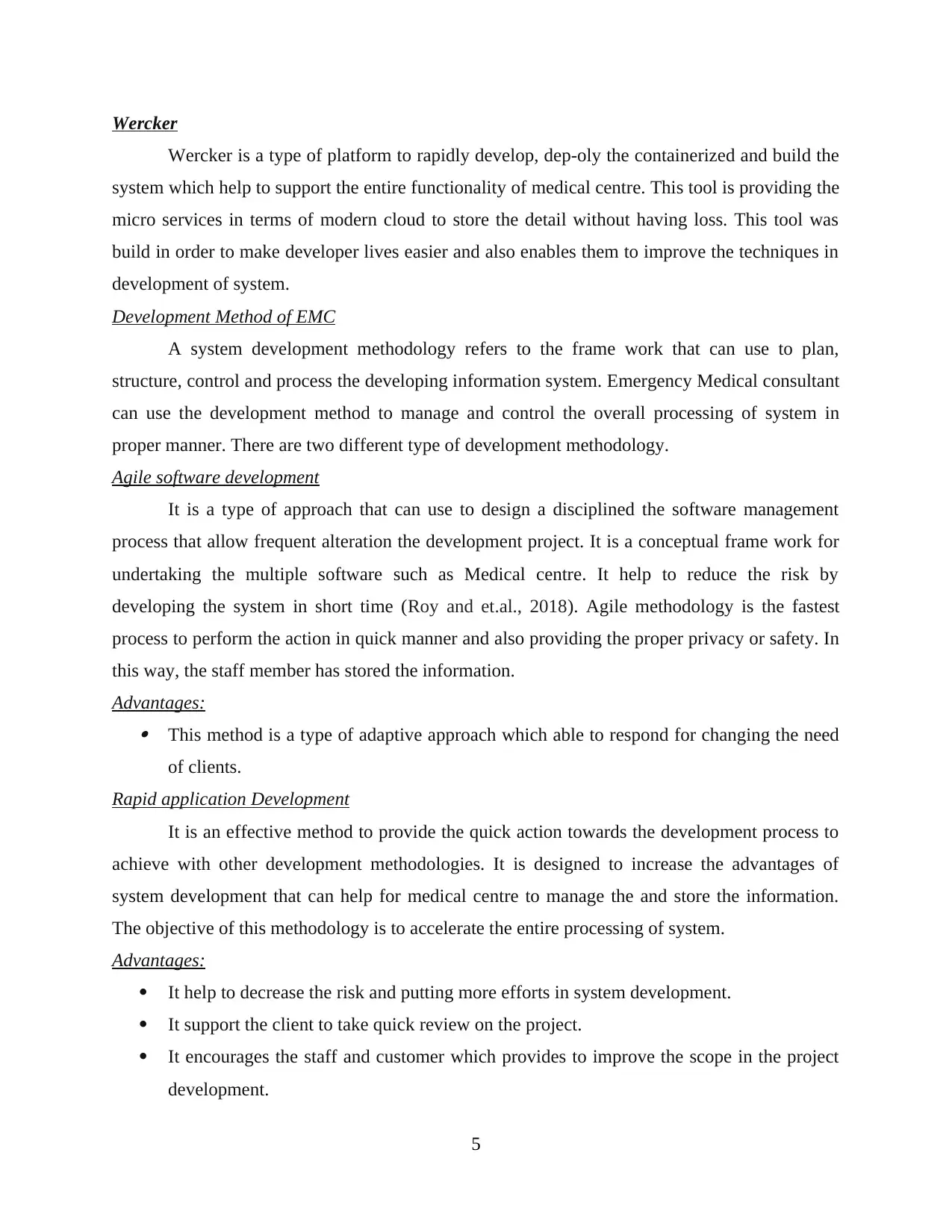
Wercker
Wercker is a type of platform to rapidly develop, dep-oly the containerized and build the
system which help to support the entire functionality of medical centre. This tool is providing the
micro services in terms of modern cloud to store the detail without having loss. This tool was
build in order to make developer lives easier and also enables them to improve the techniques in
development of system.
Development Method of EMC
A system development methodology refers to the frame work that can use to plan,
structure, control and process the developing information system. Emergency Medical consultant
can use the development method to manage and control the overall processing of system in
proper manner. There are two different type of development methodology.
Agile software development
It is a type of approach that can use to design a disciplined the software management
process that allow frequent alteration the development project. It is a conceptual frame work for
undertaking the multiple software such as Medical centre. It help to reduce the risk by
developing the system in short time (Roy and et.al., 2018). Agile methodology is the fastest
process to perform the action in quick manner and also providing the proper privacy or safety. In
this way, the staff member has stored the information.
Advantages: This method is a type of adaptive approach which able to respond for changing the need
of clients.
Rapid application Development
It is an effective method to provide the quick action towards the development process to
achieve with other development methodologies. It is designed to increase the advantages of
system development that can help for medical centre to manage the and store the information.
The objective of this methodology is to accelerate the entire processing of system.
Advantages:
It help to decrease the risk and putting more efforts in system development.
It support the client to take quick review on the project.
It encourages the staff and customer which provides to improve the scope in the project
development.
5
Wercker is a type of platform to rapidly develop, dep-oly the containerized and build the
system which help to support the entire functionality of medical centre. This tool is providing the
micro services in terms of modern cloud to store the detail without having loss. This tool was
build in order to make developer lives easier and also enables them to improve the techniques in
development of system.
Development Method of EMC
A system development methodology refers to the frame work that can use to plan,
structure, control and process the developing information system. Emergency Medical consultant
can use the development method to manage and control the overall processing of system in
proper manner. There are two different type of development methodology.
Agile software development
It is a type of approach that can use to design a disciplined the software management
process that allow frequent alteration the development project. It is a conceptual frame work for
undertaking the multiple software such as Medical centre. It help to reduce the risk by
developing the system in short time (Roy and et.al., 2018). Agile methodology is the fastest
process to perform the action in quick manner and also providing the proper privacy or safety. In
this way, the staff member has stored the information.
Advantages: This method is a type of adaptive approach which able to respond for changing the need
of clients.
Rapid application Development
It is an effective method to provide the quick action towards the development process to
achieve with other development methodologies. It is designed to increase the advantages of
system development that can help for medical centre to manage the and store the information.
The objective of this methodology is to accelerate the entire processing of system.
Advantages:
It help to decrease the risk and putting more efforts in system development.
It support the client to take quick review on the project.
It encourages the staff and customer which provides to improve the scope in the project
development.
5
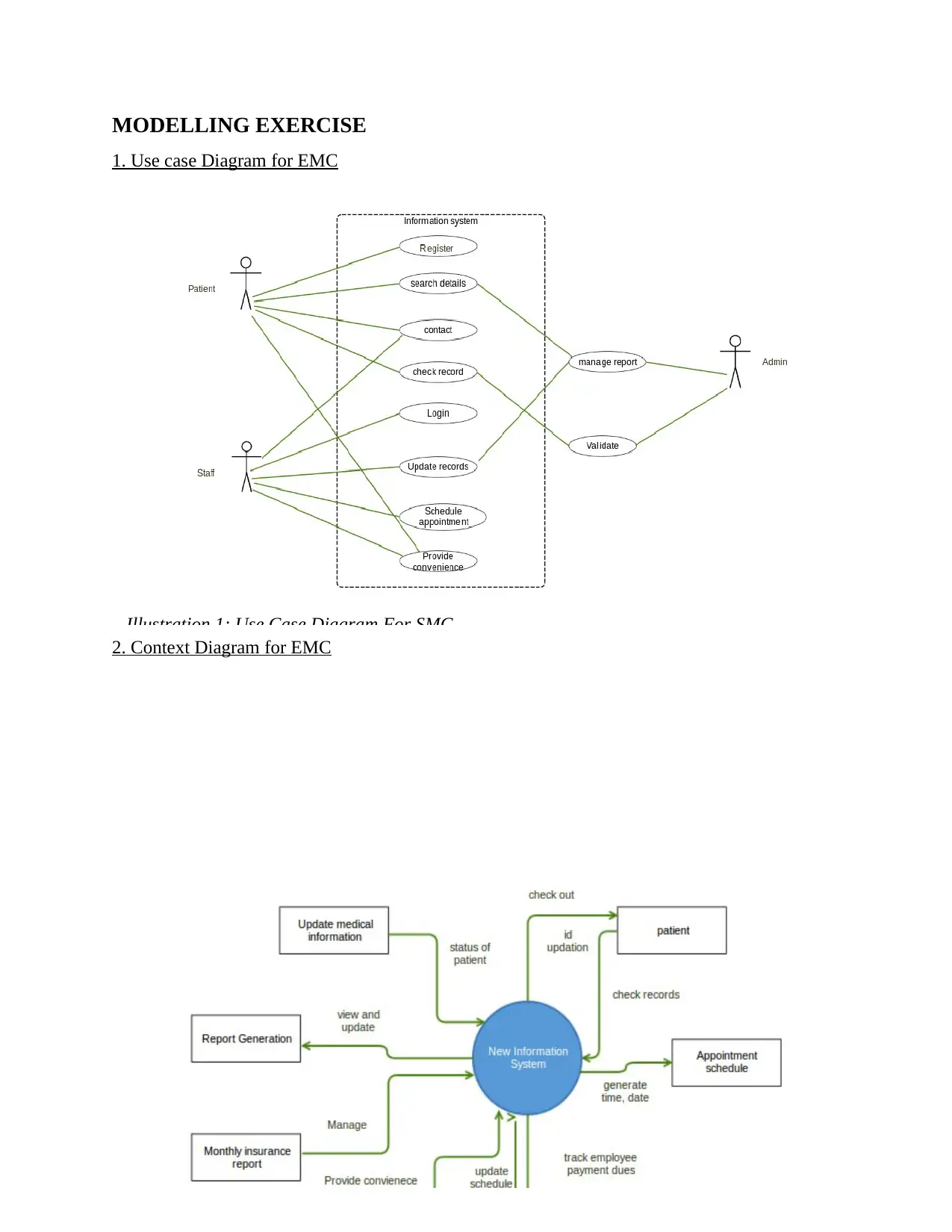
MODELLING EXERCISE
1. Use case Diagram for EMC
2. Context Diagram for EMC
6
Illustration 1: Use Case Diagram For SMC
1. Use case Diagram for EMC
2. Context Diagram for EMC
6
Illustration 1: Use Case Diagram For SMC
⊘ This is a preview!⊘
Do you want full access?
Subscribe today to unlock all pages.

Trusted by 1+ million students worldwide
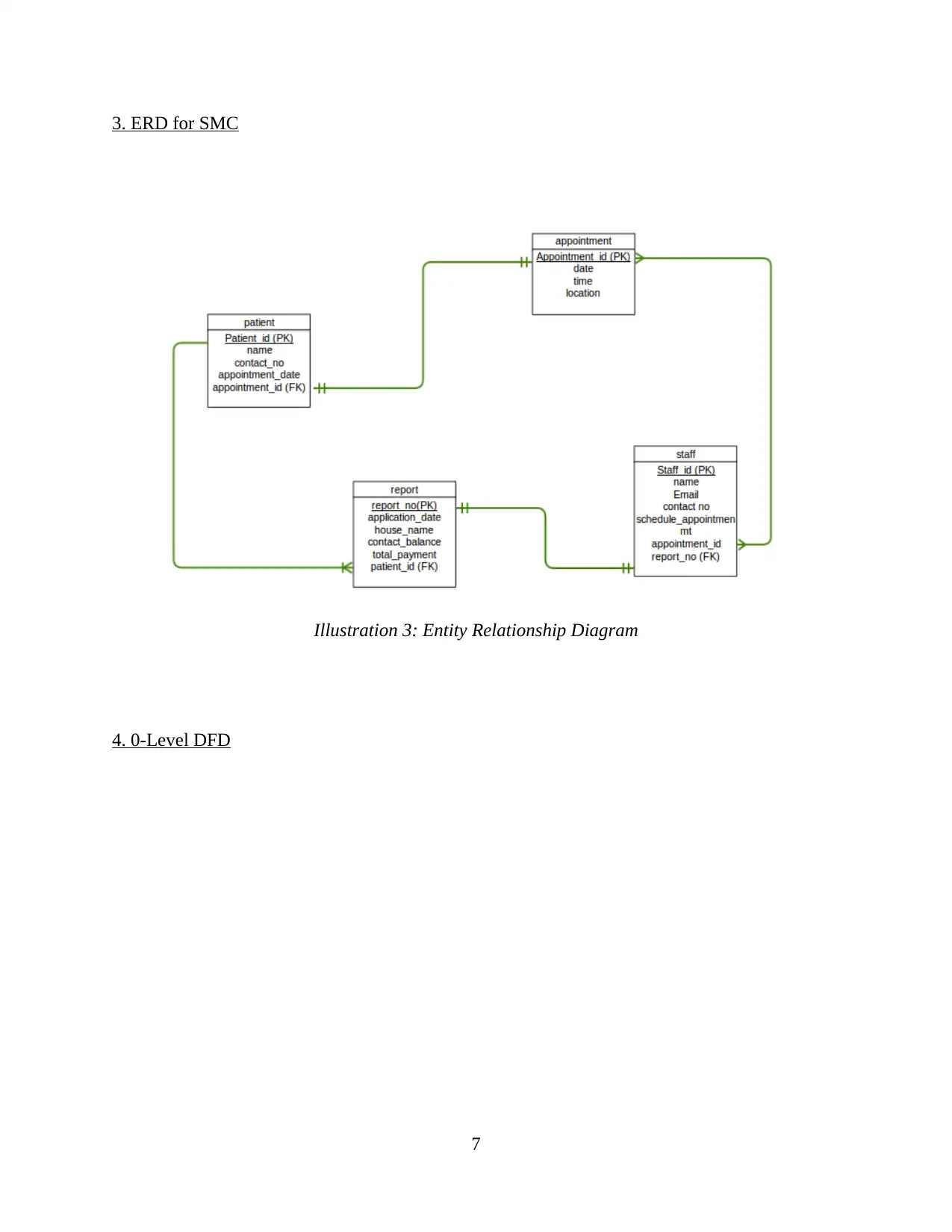
3. ERD for SMC
4. 0-Level DFD
7
Illustration 3: Entity Relationship Diagram
4. 0-Level DFD
7
Illustration 3: Entity Relationship Diagram
Paraphrase This Document
Need a fresh take? Get an instant paraphrase of this document with our AI Paraphraser
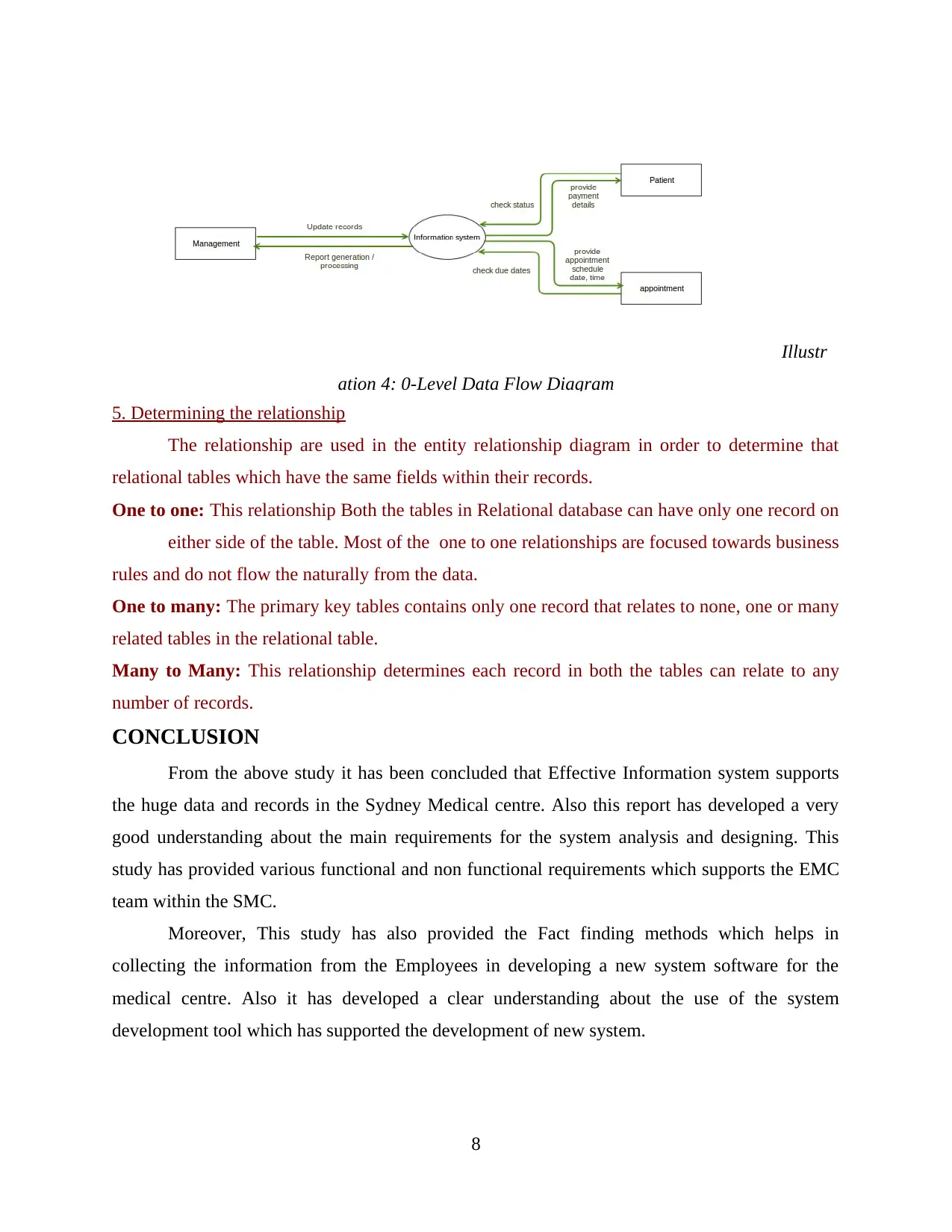
5. Determining the relationship
The relationship are used in the entity relationship diagram in order to determine that
relational tables which have the same fields within their records.
One to one: This relationship Both the tables in Relational database can have only one record on
either side of the table. Most of the one to one relationships are focused towards business
rules and do not flow the naturally from the data.
One to many: The primary key tables contains only one record that relates to none, one or many
related tables in the relational table.
Many to Many: This relationship determines each record in both the tables can relate to any
number of records.
CONCLUSION
From the above study it has been concluded that Effective Information system supports
the huge data and records in the Sydney Medical centre. Also this report has developed a very
good understanding about the main requirements for the system analysis and designing. This
study has provided various functional and non functional requirements which supports the EMC
team within the SMC.
Moreover, This study has also provided the Fact finding methods which helps in
collecting the information from the Employees in developing a new system software for the
medical centre. Also it has developed a clear understanding about the use of the system
development tool which has supported the development of new system.
8
Illustr
ation 4: 0-Level Data Flow Diagram
The relationship are used in the entity relationship diagram in order to determine that
relational tables which have the same fields within their records.
One to one: This relationship Both the tables in Relational database can have only one record on
either side of the table. Most of the one to one relationships are focused towards business
rules and do not flow the naturally from the data.
One to many: The primary key tables contains only one record that relates to none, one or many
related tables in the relational table.
Many to Many: This relationship determines each record in both the tables can relate to any
number of records.
CONCLUSION
From the above study it has been concluded that Effective Information system supports
the huge data and records in the Sydney Medical centre. Also this report has developed a very
good understanding about the main requirements for the system analysis and designing. This
study has provided various functional and non functional requirements which supports the EMC
team within the SMC.
Moreover, This study has also provided the Fact finding methods which helps in
collecting the information from the Employees in developing a new system software for the
medical centre. Also it has developed a clear understanding about the use of the system
development tool which has supported the development of new system.
8
Illustr
ation 4: 0-Level Data Flow Diagram
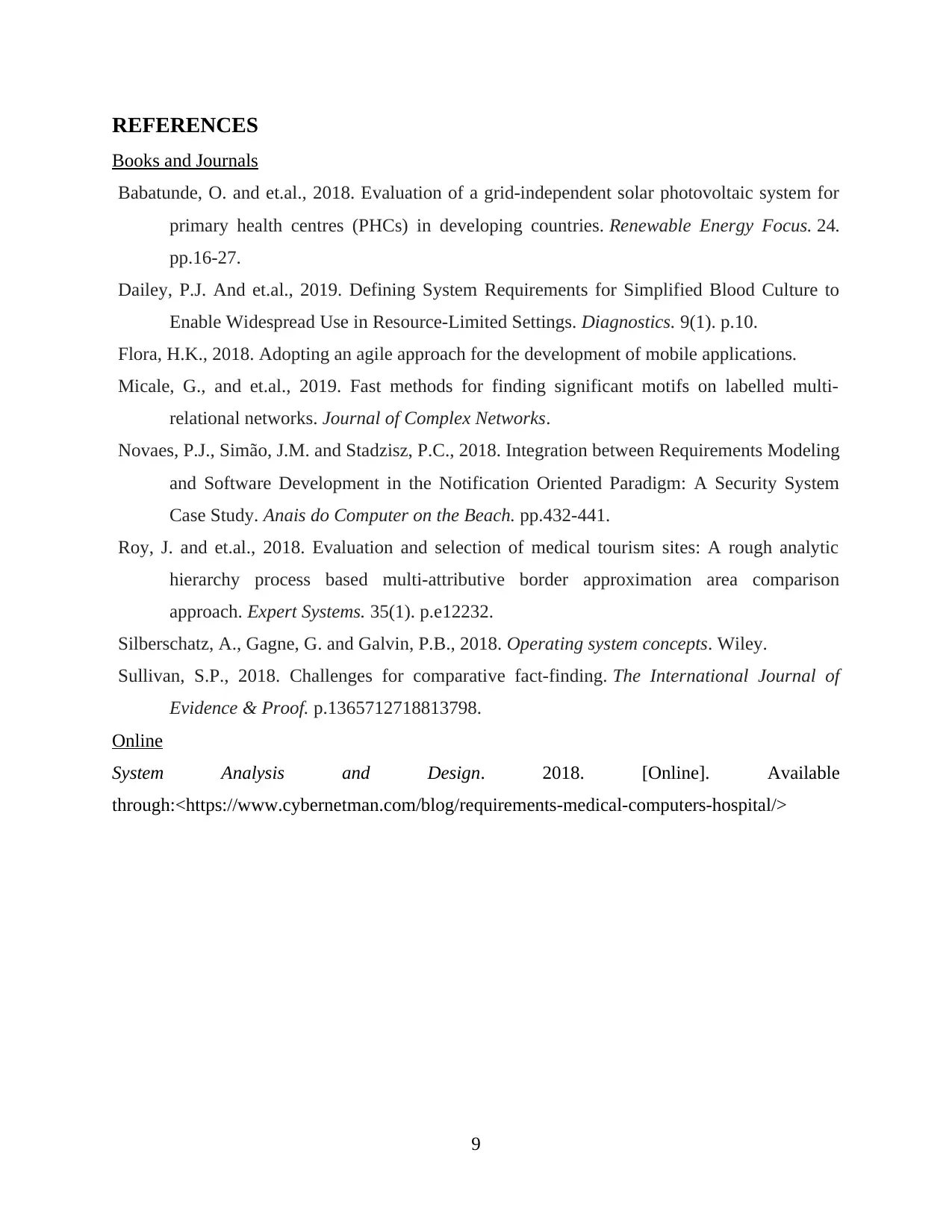
REFERENCES
Books and Journals
Babatunde, O. and et.al., 2018. Evaluation of a grid-independent solar photovoltaic system for
primary health centres (PHCs) in developing countries. Renewable Energy Focus. 24.
pp.16-27.
Dailey, P.J. And et.al., 2019. Defining System Requirements for Simplified Blood Culture to
Enable Widespread Use in Resource-Limited Settings. Diagnostics. 9(1). p.10.
Flora, H.K., 2018. Adopting an agile approach for the development of mobile applications.
Micale, G., and et.al., 2019. Fast methods for finding significant motifs on labelled multi-
relational networks. Journal of Complex Networks.
Novaes, P.J., Simão, J.M. and Stadzisz, P.C., 2018. Integration between Requirements Modeling
and Software Development in the Notification Oriented Paradigm: A Security System
Case Study. Anais do Computer on the Beach. pp.432-441.
Roy, J. and et.al., 2018. Evaluation and selection of medical tourism sites: A rough analytic
hierarchy process based multi‐attributive border approximation area comparison
approach. Expert Systems. 35(1). p.e12232.
Silberschatz, A., Gagne, G. and Galvin, P.B., 2018. Operating system concepts. Wiley.
Sullivan, S.P., 2018. Challenges for comparative fact-finding. The International Journal of
Evidence & Proof. p.1365712718813798.
Online
System Analysis and Design. 2018. [Online]. Available
through:<https://www.cybernetman.com/blog/requirements-medical-computers-hospital/>
9
Books and Journals
Babatunde, O. and et.al., 2018. Evaluation of a grid-independent solar photovoltaic system for
primary health centres (PHCs) in developing countries. Renewable Energy Focus. 24.
pp.16-27.
Dailey, P.J. And et.al., 2019. Defining System Requirements for Simplified Blood Culture to
Enable Widespread Use in Resource-Limited Settings. Diagnostics. 9(1). p.10.
Flora, H.K., 2018. Adopting an agile approach for the development of mobile applications.
Micale, G., and et.al., 2019. Fast methods for finding significant motifs on labelled multi-
relational networks. Journal of Complex Networks.
Novaes, P.J., Simão, J.M. and Stadzisz, P.C., 2018. Integration between Requirements Modeling
and Software Development in the Notification Oriented Paradigm: A Security System
Case Study. Anais do Computer on the Beach. pp.432-441.
Roy, J. and et.al., 2018. Evaluation and selection of medical tourism sites: A rough analytic
hierarchy process based multi‐attributive border approximation area comparison
approach. Expert Systems. 35(1). p.e12232.
Silberschatz, A., Gagne, G. and Galvin, P.B., 2018. Operating system concepts. Wiley.
Sullivan, S.P., 2018. Challenges for comparative fact-finding. The International Journal of
Evidence & Proof. p.1365712718813798.
Online
System Analysis and Design. 2018. [Online]. Available
through:<https://www.cybernetman.com/blog/requirements-medical-computers-hospital/>
9
⊘ This is a preview!⊘
Do you want full access?
Subscribe today to unlock all pages.

Trusted by 1+ million students worldwide
1 out of 16
Related Documents
Your All-in-One AI-Powered Toolkit for Academic Success.
+13062052269
info@desklib.com
Available 24*7 on WhatsApp / Email
![[object Object]](/_next/static/media/star-bottom.7253800d.svg)
Unlock your academic potential
Copyright © 2020–2025 A2Z Services. All Rights Reserved. Developed and managed by ZUCOL.




